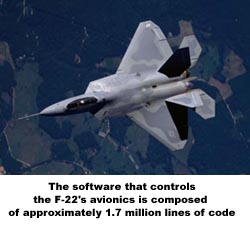Today, that same computing power has been packaged into a small device
a little bigger than a business card. The size, weight and power requirements
for these types of modules continue to drop. Now we know that the original
goals were, indeed, achievable. Such a quantum leap in capability has
not been limited to the F-22 aircraft itself.
Computational power has greatly changed the use of computers in all
aspects of the F-22 program from design, through manufacturing, and
even the testing of the airplane. CATIA and COMOK The computer revolution
has changed the detail design process of the aircraft. In association
with IBM, Dassault Systems designed "computer-aided, three-dimensional
interactive application" (CATIA).
As a result, the aircraft designer can design the parts of the F-22
as a solid object, not just lines on a flat page. With COMOK (a "team-developed
computer mockup simulation"), the designer can visualize every aspect
of the design including complex routing for wires, tubes and cables.
There is no hard mockup of the F-22.
These computer programs allow the design engineer and the manufacturing
engineer to look inside the structure before it is built. More than
just a visualization, the computer data that creates these images are
precisely-stored design measurements that can be transferred, again
by computers, between the team's locations in Marietta, Ga., Fort Worth
Texas, Seattle, Wash., and West Palm Beach Fla., and East Hartford,
Conn., and supplier locations all around the country.
Even though no master tool was sent to trial-fit the pieces, the various
parts of the aircraft fit remarkably well when received in Marietta,
where final assembly took place.
